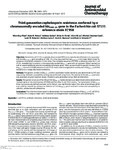Third-generation cephalosporin resistance conferred by a chromosomally encoded blaCMY-23 gene in the Escherichia coli ST131 reference strain EC958
| dc.contributor.author | Phan, M-D | |
| dc.contributor.author | Peters, KM | |
| dc.contributor.author | Sarkar, S | |
| dc.contributor.author | Forde, BM | |
| dc.contributor.author | Lo, AW | |
| dc.contributor.author | Stanton-Cook, M | |
| dc.contributor.author | Roberts, LW | |
| dc.contributor.author | Upton, Mathew | |
| dc.contributor.author | Beatson, SA | |
| dc.contributor.author | Schembri, MA | |
| dc.date.accessioned | 2018-03-10T10:07:43Z | |
| dc.date.available | 2018-03-10T10:07:43Z | |
| dc.date.issued | 2015-03-18 | |
| dc.identifier.issn | 0305-7453 | |
| dc.identifier.issn | 1460-2091 | |
| dc.identifier.uri | http://hdl.handle.net/10026.1/11054 | |
| dc.description.abstract |
<jats:title>Abstract</jats:title> <jats:sec> <jats:title>Objectives</jats:title> <jats:p>Escherichia coli ST131 is a globally disseminated MDR clone originally identified due to its association with the blaCTX-M-15 gene encoding an ESBL. It is thus assumed that blaCTX-M-15 is the major determinant for resistance to β-lactam antibiotics in this clone. The complete sequence of EC958, a reference strain for E. coli ST131, revealed that it contains a chromosomally located blaCMY-23 gene with an upstream ISEcp1 element as well as several additional plasmid-encoded β-lactamase genes. Here, we examined the genetic context of the blaCMY-23 element in EC958 and other E. coli ST131 strains and investigated the contribution of blaCMY-23 to EC958 resistance to a range of β-lactam antibiotics.</jats:p> </jats:sec> <jats:sec> <jats:title>Methods</jats:title> <jats:p>The genetic context of blaCMY-23 and its associated mobile elements was determined by PCR and sequencing. Antibiotic susceptibility testing was performed using Etests. The activity of the blaCMY-23 promoter was assessed using lacZ reporter assays. Mutations were generated using λ-Red-recombination.</jats:p> </jats:sec> <jats:sec> <jats:title>Results</jats:title> <jats:p>The genetic structure of the ISEcp1-IS5-blaCMY-23 mobile element was determined and localized within the betU gene on the chromosome of EC958 and five other E. coli ST131 strains. The transcription of blaCMY-23, driven by a previously defined promoter within ISEcp1, was significantly higher than other β-lactamase genes and could be induced by cefotaxime. Deletion of the blaCMY-23 gene resulted in enhanced susceptibility to cefoxitin, cefotaxime and ceftazidime.</jats:p> </jats:sec> <jats:sec> <jats:title>Conclusions</jats:title> <jats:p>This is the first known report to demonstrate the chromosomal location of blaCMY-23 in E. coli ST131. In EC958, CMY-23 plays a major role in resistance to third-generation cephalosporins and cephamycins.</jats:p> </jats:sec> | |
| dc.format.extent | 1969-1972 | |
| dc.format.medium | Print-Electronic | |
| dc.language | en | |
| dc.language.iso | en | |
| dc.publisher | Oxford University Press (OUP) | |
| dc.subject | E. coli ST131 | |
| dc.subject | antibiotic resistance | |
| dc.subject | AmpC beta-lactamases | |
| dc.title | Third-generation cephalosporin resistance conferred by a chromosomally encoded blaCMY-23 gene in the Escherichia coli ST131 reference strain EC958 | |
| dc.type | journal-article | |
| dc.type | Journal Article | |
| dc.type | Research Support, Non-U.S. Gov't | |
| plymouth.author-url | https://www.webofscience.com/api/gateway?GWVersion=2&SrcApp=PARTNER_APP&SrcAuth=LinksAMR&KeyUT=WOS:000359722900007&DestLinkType=FullRecord&DestApp=ALL_WOS&UsrCustomerID=11bb513d99f797142bcfeffcc58ea008 | |
| plymouth.issue | 7 | |
| plymouth.volume | 70 | |
| plymouth.publication-status | Published online | |
| plymouth.journal | Journal of Antimicrobial Chemotherapy | |
| dc.identifier.doi | 10.1093/jac/dkv066 | |
| plymouth.organisational-group | /Plymouth | |
| plymouth.organisational-group | /Plymouth/Faculty of Health | |
| plymouth.organisational-group | /Plymouth/Faculty of Health/School of Biomedical Sciences | |
| plymouth.organisational-group | /Plymouth/REF 2021 Researchers by UoA | |
| plymouth.organisational-group | /Plymouth/REF 2021 Researchers by UoA/UoA01 Clinical Medicine | |
| plymouth.organisational-group | /Plymouth/Research Groups | |
| plymouth.organisational-group | /Plymouth/Research Groups/Institute of Translational and Stratified Medicine (ITSMED) | |
| plymouth.organisational-group | /Plymouth/Research Groups/Institute of Translational and Stratified Medicine (ITSMED)/CBR | |
| plymouth.organisational-group | /Plymouth/Research Groups/Plymouth Institute of Health and Care Research (PIHR) | |
| plymouth.organisational-group | /Plymouth/Users by role | |
| plymouth.organisational-group | /Plymouth/Users by role/Academics | |
| plymouth.organisational-group | /Plymouth/Users by role/Researchers in ResearchFish submission | |
| dc.publisher.place | England | |
| dcterms.dateAccepted | 2015-02-20 | |
| dc.identifier.eissn | 1460-2091 | |
| dc.rights.embargoperiod | Not known | |
| rioxxterms.versionofrecord | 10.1093/jac/dkv066 | |
| rioxxterms.licenseref.uri | http://www.rioxx.net/licenses/all-rights-reserved | |
| rioxxterms.licenseref.startdate | 2015-03-18 | |
| rioxxterms.type | Journal Article/Review |


